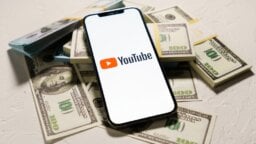YouTube has claimed that it paid out over $1.8bn to music rights-holders in the 12 months to the end of September this year, in advertising revenues alone.
The figure is revealed in Google‘s new ‘How Google Fights Piracy’ report, in which it’s also claimed that YouTube has paid out more than $6bn to the music industry to date – $3bn of which has come from the monetized use of music in videos via Content ID.
These numbers get extra interesting when we turn back the clock a little bit – and, naturally, when we also look into how they compare to Spotify‘s industry payouts.

Spotify recently revealed that it had paid out €10bn to music rights-holders from its launch in 2008 all the way up to August 31 this year.
In Spotify’s own F-1 filing with the New York Stock Exchange, it revealed that it had paid the music business €8bn from the platform’s launch to the end of 2017, meaning that, in the first eight months of this year, Daniel Ek’s firm handed over circa €2bn to labels and publishers etc.
Spotify, then, is running at an average per-month payout rate of €250m, which, according to an average exchange rate across the period, handily translates into USD at $300m (or $299.66m, to be more precise).
So there you have it: YouTube is paying rights-holders around $150m a month in ad money, while Spotify is paying out $300m a month in ads plus premium subscriptions.
Time will tell if those two headline numbers will grow closer together as YouTube continues to market and roll out its premium YouTube Music app, which launched in June.
Interesting twist: Spotify’s ad-funded revenues are currently tracking at around €47m/$54m per month according to its recent Q3 report. If we roughly estimate that 70% of this is going to rights-holders, that means Spotify is handing over around $38m per month to the music industry in ad money – around a quarter of YouTube’s equivalent figure.
It’s also worth noting the acceleration in YouTube’s payments to the industry over the past couple of years.
In December 2016, YouTube said it had paid out circa $1 billion to the music business in the prior 12 months.
In the same timeframe, to end of September this year, that figure had grown by 80% to $1.8bn.
Finally, let’s remember the disparity between what YouTube says it’s paying out to rights-holders, and what those same rights-holders claim YouTube pays out.
According to the IFPI’s global report for 2017, all digital video platforms (mainly YouTube) paid out just $856m to rights holders in the year.
Yet according to YouTube’s own figures, it’s now paying more than double this amount to labels, publishers, songwriters and artists within a 12 month timeframe.
In August last year, YouTube’s global Head of Music, Lyor Cohen (pictured), claimed that YouTube was paying a higher per-stream rate for ad-funded plays than Spotify or Pandora within the United States.
He wrote: “Critics complain YouTube isn’t paying enough money for ad-supported streams compared to Spotify or Pandora. I was one of them! Then I got here and looked at the numbers myself.
“At over $3 per thousand streams in the U.S., YouTube is paying out more than other ad-supported services.
“Why doesn’t anyone know that? Because YouTube is global and the numbers get diluted by lower contributions in developing markets.
“But they’re working the ads hustle like crazy so payouts can ramp up quickly all around the world. If they can do that, this industry could double in the next few years.”
To be fair to Cohen, YouTube’s own industry payout figures suggest that the company’s monetary contribution to the music industry has almost doubled in the near-two years since the end of 2016.Music Business Worldwide




